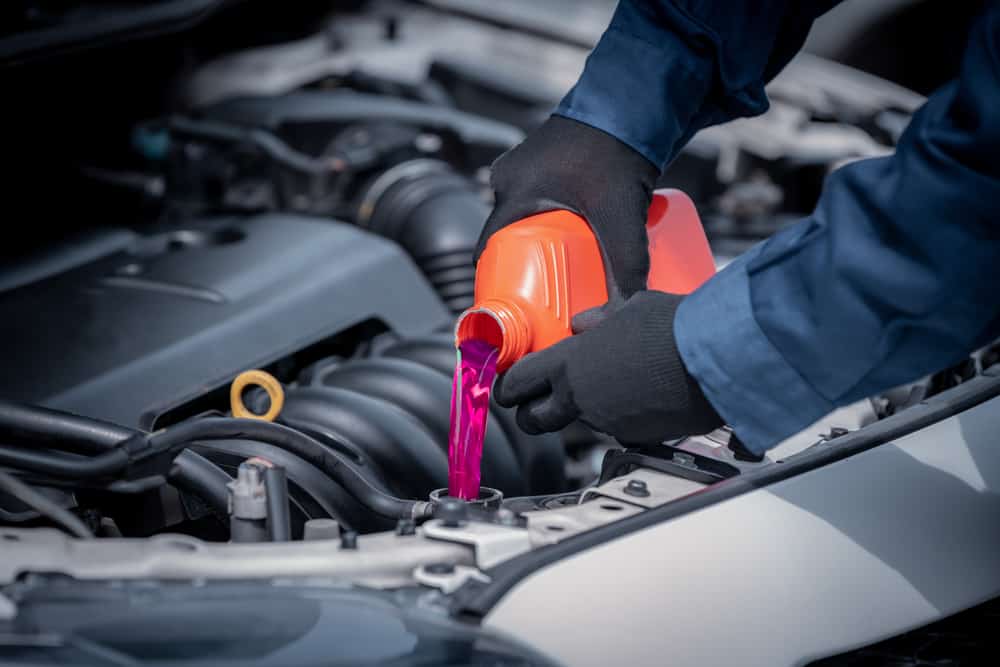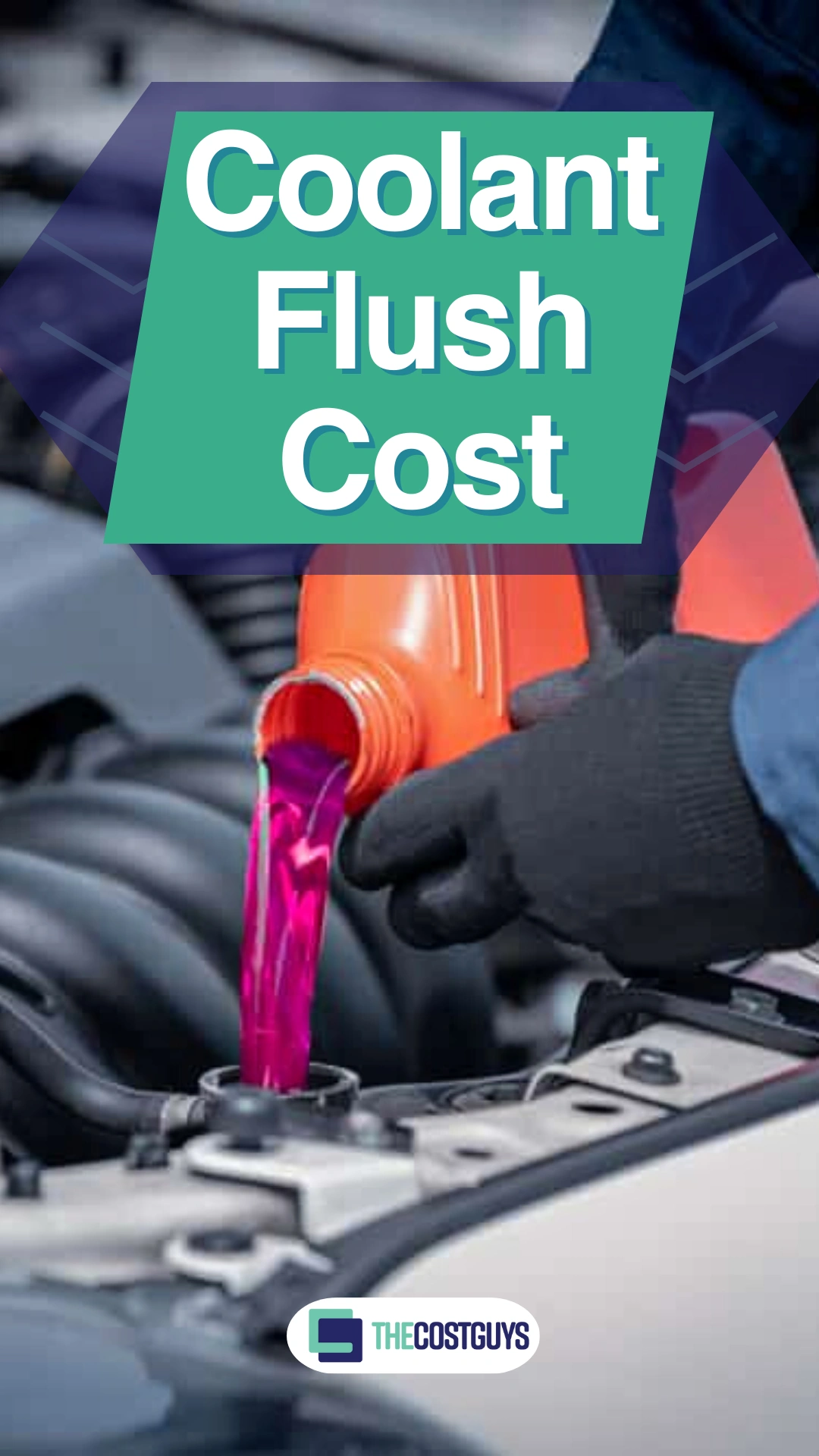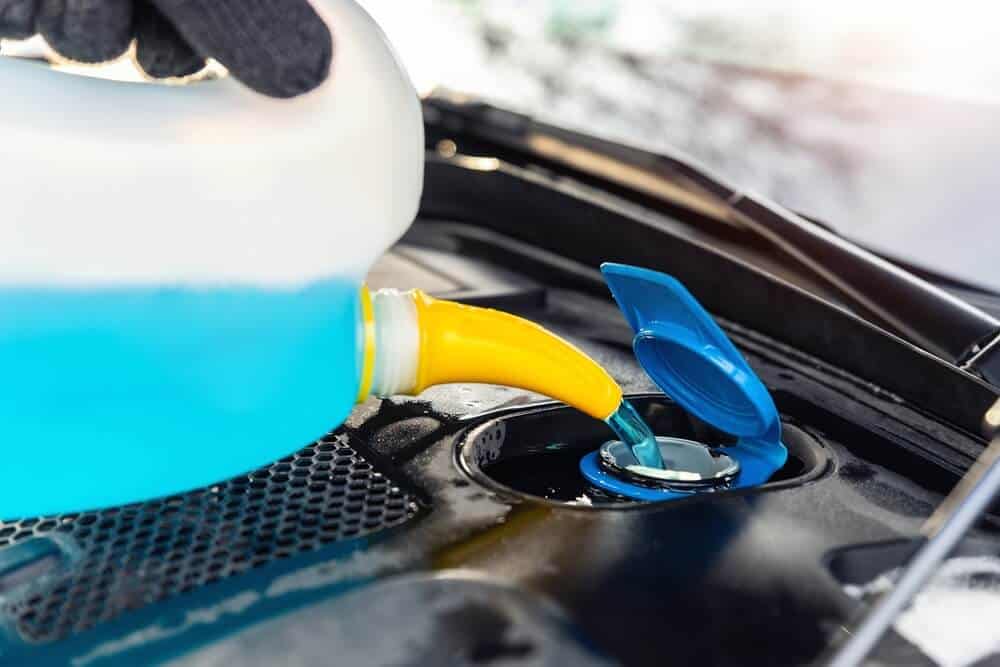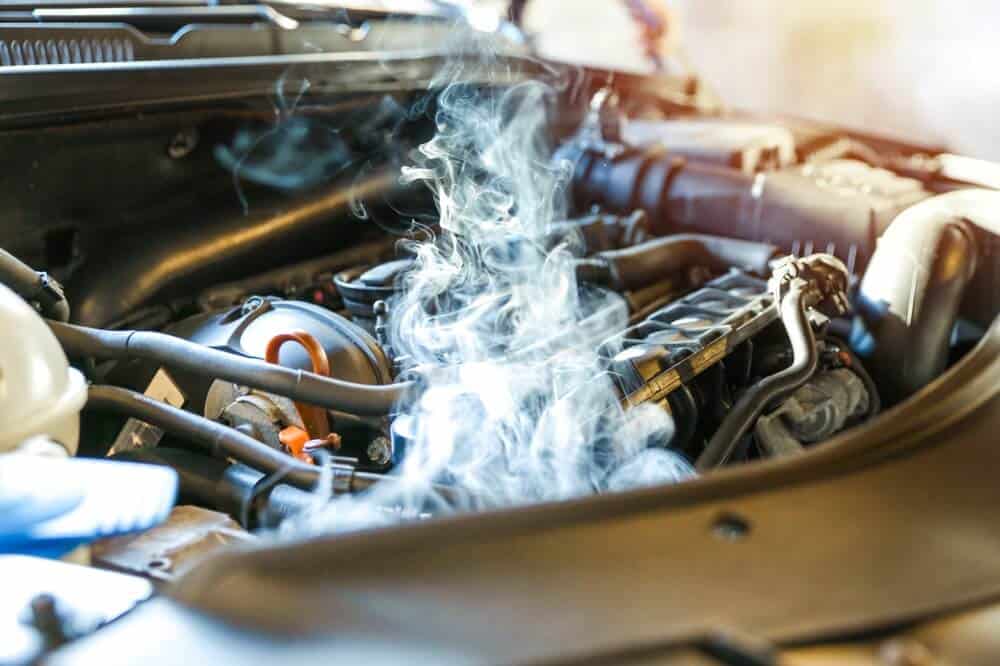Coolant flushes can save your engine from clogs and even overheating as a result of built-up and deposits. These happen, whether you exclusively use coolant products or use water.
Scale, contaminants, and rust deposits build up over time, which can cause issues in your coolant system, in the radiator, and in the pump and lines.
An occasional coolant flush, usually about every 2 years, should keep your coolant system in good working order.

The average cost of a coolant flush is $50-$250. In most cases, you can expect to pay about $150 for the flush and the new coolant. However, if you have high-end coolant, you might pay as much as $100 more.

The table below shows a quick price comparison of coolant flush cost estimates from reputable suppliers:
| Supplier | Coolant + Cleaning Fluid | Labor |
|---|---|---|
| YourMechanic | $58-$64 | $143.48 |
| Midas | Free | $129.99 |
| Valvoline | Free | $99 |
| Firestones | Free | $54-$144 |
| Jiffy Lube | Free | $99.99 |
| Pep Boys | Free | $54.99-$94.99 |
Compare Car Warranty Quotes For Free & Save Big!
Topics
Coolant Flush Cost Estimates*
In most cases, you can expect to pay about $150 for a coolant flush from a mechanic. That might go as low as $50 or as high as $250, however, the higher extreme is rare.
In addition, you can almost always choose to flush the system yourself. This will reduce the cost to the $2-$12 a liter for your coolant, or usually $10-$25.
Here, costs might vary slightly from car to car. However, in most cases, you’re looking at pricing based on coolant and your mechanic.
The following chart covers estimates for flushing the coolant in 10 popular vehicle models.
| Vehicle | Coolant Flush Cost |
|---|---|
| Chevy Malibu | $71-$421 |
| Nissan Rogue | $71-$276 |
| Honda Accord | $59-$142 |
| Nissan Altima | $107-$236 |
| Chevy Impala | $102-$157 |
| Lexus Rx 350 | $197-$449 |
| Ford F150 | $97-$262 |
| Toyota Corolla | $99-$172 |
| Honda Civic | $70-$230 |
| Toyota Camry | $114-$234 |
*Note: Prices are estimates and were correct at the time of writing (February 2022). Cost estimates may have changed since, our figures should be used as a starting point for your own research.
Coolant Flush Price Factors

There are a couple of factors that impact the cost of a coolant flush. However, most of these costs are minimal.
The most important cost will always be labor. Here, you’ll want to pay special attention to what you’re getting for the money and why you’re paying that.
For example, most dealerships can charge well in excess of standard rates. E.g., the Chevy dealerships normally charge $400 for a coolant flush.
Cost of Labor
Labor is the most important cost in a coolant flush. Here, your mechanic will have to drain the fluid, flush out the system, and then refill the fluid. This can take 15 minutes to half an hour.
So, in most cases, you’ll pay the minimum rate for the mechanic plus shop fees. Normally that’s an hour of work plus 20%.
In other cases, it will cost less. Mechanic’s rates range from $15-$210, but you can expect an average of about $60.
In addition, some shops will use a pressurized system to flush out debris from the system. This isn’t always necessary. In some systems, it’s also impossible.
So, your debris flush might consist of filling the radiator up with water and idling the engine for 15-20 minutes, and then draining it again. Your mechanic will still spend that extra time on doing so.
On the other hand, many nationwide chains or dealers offer flat-rate coolant flushes. For example, Valvoline and Jiffy Lube each offer a $99 flush. YourMechanic charges a flat rate of $143 but also charges for coolant.
Many dealers also offer coupons and discounts, which you can clip from newspapers or get on Groupon – these can greatly reduce the cost of your flush.
Replacement Coolant
Replacement coolant is normally very cheap. However, costs can vary significantly.
Normally you can expect to pay anywhere from $10-$50+ for new coolant. In addition, if you’re buying coolant via a dealer or at a mechanic, you can expect to pay a bit more for it than if you pick it up at your local Autoparts store or Walmart.
And, in some cases, your dealer will actually charge a premium for coolant.
Make and Model
The make and model of your car have a slight amount of impact on the cost of a coolant exchange.
For example, if your model is particularly difficult to drain or drains very slowly. Or, if you have a performance vehicle, it needs a more efficient coolant.
In most cases, the impact of make and model is minimal. For example, you can normally stick any compatible coolant into your car.
Signs You Need a Coolant Flush

In most cases, you’ll want to flush your coolant every 2 years or so. However, if you’ve missed that date or something has gone wrong, your engine will normally let you know that something is going wrong.
In that case, you can look for the following symptoms.
Overheating
If you notice the temperature gauge is getting high or if your vehicle is actually overheating and shutting down, it’s likely a coolant problem. However, it might be a leak, low coolant, a clog, or even a faulty pump.
You’ll want to inspect the system to see what’s going on before you determine that a simple flush will do the job.
For example, if you flush the system but it turns out the water pump is bad, you’ll have to flush the system again, which will waste the coolant.
Engine Noises
If the coolant is low, it’s likely that your engine will knock or grind.
This often happens when coolant flows back into the heater, usually because the engine is reading things as too warm. This could indicate a problem with the coolant.
However, it might also mean you have a faulty thermostat. You can also listen for gurgling, grinding, or other sounds coming from the coolant reservoir and the hoses.
Leaking Coolant
Leaking coolant always means you have to flush the system, replace the valves or hoses, and add new coolant.
In most cases, you can recognize a leak either through liquid spills or from a sweet smell emanating from under the hood. Here, coolant is usually easy to recognize.
Most people use antifreeze in their vehicle year-round. And, this coolant is toxic, so it’s brightly colored pink or green to prevent children and animals from trying it.
If you notice leaks, you should get the problem fixed immediately. That’s both to prevent damage to the system and to prevent damage to animals and plants.
Coolant Level is Low
If your coolant level is low, you either have a leak or the engine is running too hot, or it’s been a long time since you replaced the coolant. The lower your coolant, the more likely it is that you overheat.
So, the two issues can play into each other. And, if your coolant is empty, you definitely have a leak.
Here, you’ll want to flush the system, drain it, and then refill it again.
How Coolant Is Flushed (12 Steps)
Flushing radiator coolant is a simple process, and most people can do it at home, to the same quality as at a mechanic. You’ll also only need a few simple tools.
However, you will have to practice safety and make sure you can safely dispose of coolant. Antifreeze is extremely toxic and should never be flushed into drains or disposed of on the ground.
Things You’ll Need:
- Floor jack + jack stands
- Screwdriver or wrench matching the radiator plug on your vehicle if it doesn’t have a wing nut
- A flat screwdriver
- A large drain pan (at least 5 liters)
- A 5 liter disposable plastic jug
- A funnel
- A large plastic bag or plastic spread for safety purposes
- Disposable gloves
- Replacement antifreeze
- A water source or flush cleaner
Steps:
- Jack up the front of the car and stabilize the vehicle on jack stands. You’ll want to follow the normal safety precautions of turning the ignition off and taking the key out. You might also want to block the back wheels. And, of course, set the parking brake.
- Position the drain pan under the radiator drain plug. Normally you can find this by the wing nut or bolt on the bottom of the radiator. You can choose to spread plastic further under this to catch any splash. If you have pets or small children, this is a good idea.
- Unscrew the drain plug. If it’s a wingnut you might need a pair of pliers to loosen it. Allow the coolant to drain out fully. This can take 5-10 minutes or longer.
- Disconnect the lower radiator hose from the bottom of the radiator and drain that into the drain pan.
- Reconnect the hose and close the radiator drain cap. Make sure it’s tight.
- Pour radiator flush fluid and distilled water or just distilled water into the radiator from the top. Fill it all the way up. Turn on the engine and allow it to idle for 15 minutes.
- While the engine is idling, put a funnel in the top of the disposable plastic jug. Pour the coolant from the drain pan into the jug. Make sure you use a funnel and a plastic bag or tarp to catch any splash. Seal the jug.
- Replace the drainage pan under the radiator and drain it again.
- Close everything again.
- Fill the radiator up with new coolant and seal everything.
- Turn the engine on and make sure everything is running well and there are no leaks.
- Pour the water and radiator flush into the empty radiator fluid jug. Take both to your local service station or disposal area to have them disposed of safely. Some areas have specific drop-offs for radiator fluid. However, most stores that sell radiator fluid also have collection points.
Related Questions
Flushing your radiator fluid is a relatively easy job. However, you might still have questions.
How often should coolant be flushed?
In most cases, coolant should be flushed every 2 years or every 30,000 miles, whichever comes sooner. However, if you’re noticing other problems with your coolant, you might want to flush them as well.
And, if you don’t have antifreeze in your system, you’ll want to flush the coolant and put antifreeze in before it gets cold.
What happens if you don’t flush coolant?
Coolant can degrade, debris and rust can build up, and your coolant can evaporate. Eventually, your motor will overheat more often. That can cause other problems.
Mostly, flushing coolant prevents clogs and debris from building up which functions as preventive maintenance for your water lines, radiator, and pump.
How long does a coolant flush take?
A coolant flush should take about 30 minutes with a 15-minute idle in the middle. However, you could do the whole thing in much less time if you just do a coolant exchange.
Here, you skip using water to clean out the system and just add new radiator fluid after draining the old.
Can I do my own coolant flush?
Yes. If you have a jack and the means to safely dispose of radiator fluid, you can safely do your own coolant flush.
However, even a small amount of radiator fluid can be deadly to animals and to children. Be very careful when disposing of it.
Summary
A radiator flush is a crucial part of engine maintenance. In most cases, you’ll pay about $150 for it at a mechanic. That can go up to over $250 with some mechanics.
However, you can also do the work yourself in about half an hour. Of course, there are pros and cons to both.
Compare Car Warranty Quotes For Free & Save Big!
